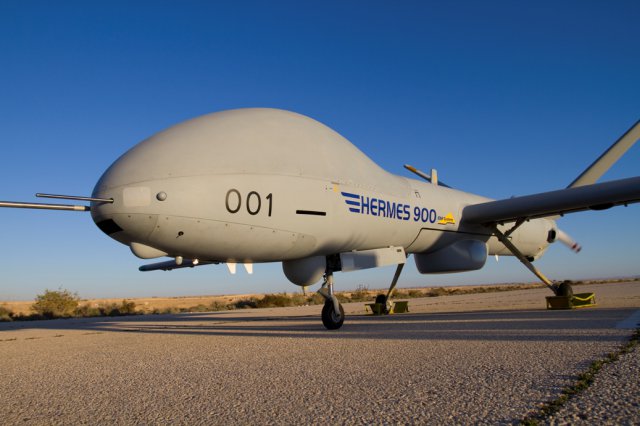Police intelligence officer Adriano Barbosa tracked the drug gang leader known as “Little P” for almost a month as part of Brazil’s push to curb violence in Rio de Janeiro’s slums before the World Cup.
The real-time reports on Little P’s whereabouts weren’t coming from police informants. Nor from undercover officers. Barbosa had a more high-tech tool for the hunt that led to the March 26 arrest: a Heron UAS outfitted with a heat-sensing camera. The Heron, produced by Israel Aerospace Industries Ltd., allowed Barbosa to monitor Little P at night, far from view and earshot.
With more than 10,000 miles of borders to monitor and a defence budget that grew four times faster than the U.S. in the past decade, Brazil is becoming a key customer for Israel, the world’s largest exporter of drones. Israeli companies including IAI and Elbit Systems Ltd. (ESLT) have edged out global competitors to win government contracts by sharing drone technology with Brazil, which is developing its own local industry as it turns to unmanned aircraft for everything from crowd monitoring at World Cup games to surveillance of crops.
“Brazil wants to build its own defence industrial base, and rather than do all the R&D themselves, they like to partner up,” Michael Blades, an analyst at consulting firm Frost & Sullivan, said in a phone interview from San Antonio in April. On these deals, “Israel has been very strong, and from what I understand more willing to transfer some of the technology.”
Israel sold $4.62 billion of unmanned aerial systems from 2005 to 2012, almost 10 percent of the country’s defence export industry in the period, according to a March 2013 report by Frost & Sullivan. Globally, the UAS industry will reach $72 billion by 2020, according to Blades.
There are about 50 legal UAS being used for civilian purposes in Brazil today while the military has between five and 10, according to Antonio Castro, a Rio de Janeiro-based consultant and head of the Brazilian Defence and Security Industries Association’s committee on UAS.
Brazil’s military spending on UAS is ranked 12th in the world through 2020, according to Frost & Sullivan. An IAI Heron would cost about $10 million, depending on the type of sensor it has, Blades said.
Elbit and state-owned IAI are profiting from Brazil’s defence strategy, announced in 2008, to shift capabilities away from conventional warfare to surveillance and protection of infrastructure and natural resources, particularly in the Amazon and offshore regions.
For Elbit, based in Haifa, Israel, it’s been a chance to make up for lost business from military budget cuts in the U.S. and Europe. The company is focusing on niche products and bolstering its efforts in Latin America and Asia, said Michael Klahr, an analyst at Citigroup Inc. in Tel Aviv.
“UAS are definitely a growth area,” he said by phone in April. “When defence budgets are being cut, they’re being cut more in terms of land forces and large projects.”
Brazil’s airforce, which already uses Elbit’s Hermes 450, bought a Hermes 900 system in the first quarter to support security and safety missions during the World Cup, the company said during a May 13 earnings call.
Elbit’s local subsidiary AEL Sistemas, a maker of avionics systems, formed a joint venture with Brazilian jetmaker Embraer SA (EMBR3) in 2011 to focus solely on UAS production.
“It’s not just for events like the World Cup, these things are needed for day-to-day things as well,” Vitor Neves, vice-president of operations at AEL Sistemas in Porto Alegre, said in a phone interview in April. “Public security secretaries are looking for more and more solutions.”
IAI is negotiating its second investment in a Brazilian company in order to compete for more government contracts, said Henrique Gomes, Chief Executive Officer of IAI’s Brazilian unit.
“The idea is to have a Brazilian-made UAS soon,” Gomes said in a May 19 e-mailed response to questions.
Brazil has boosted military spending 48 percent since 2004 to $31.5 billion in 2013, compared with a 12 percent increase in the U.S., according to the Stockholm International Peace Research Institute.
Elbit and IAI will face more competition from Brazilian companies in the area of commercial drone use, said Castro, the consultant.
The government has been subsidising Brazilian companies to develop UAS technology since 2006, and there are now seven companies capable of manufacturing unmanned aircraft, he said.
“Our companies are very well equipped in terms of technology, and so I think they’re going to be able to compete well,” Castro said. Once Brazilian regulators approve standardized rules for civilian use, which is scheduled to happen by year-end, “there’s going to be an explosion in the market,” he said.
Brazilian officials call the pre-World Cup dragnet that netted Little P a “pacification” of the favelas, the Portuguese word for shanty town. The drug lord became a key target for police as he expanded his control of Mare, one of the city’s largest slums.
In the days leading up to his arrest and the occupation that followed, 16 people were killed in Mare, according to a report by Rio’s state security secretary. Barbosa, the chief of the federal police’s intelligence division, said the use ofUAS may have prevented the loss of more lives.
“Instead of having to send police into the favela, you’re using UAS in controlled airspace,” he said. “It reduces the risks.”

